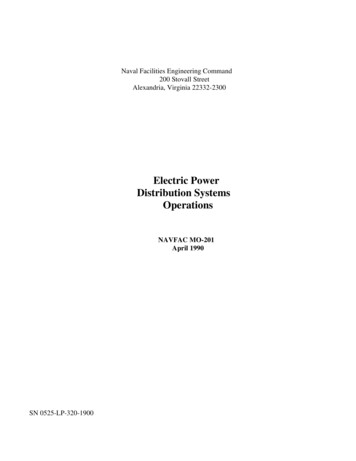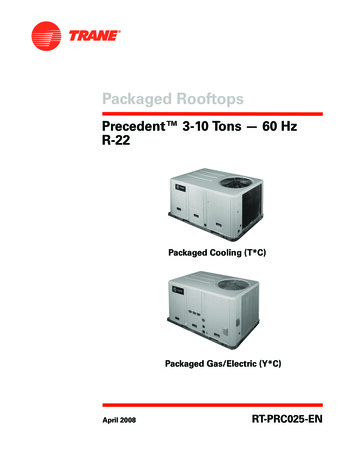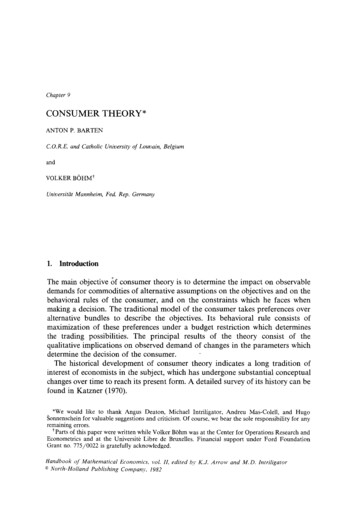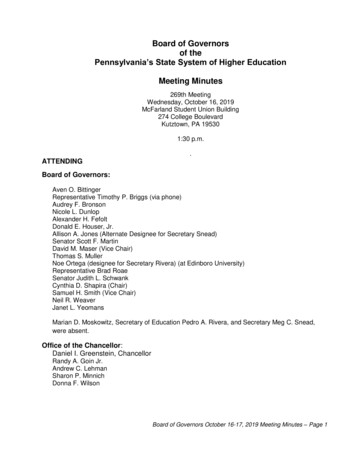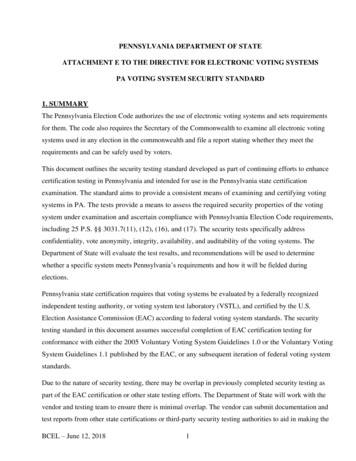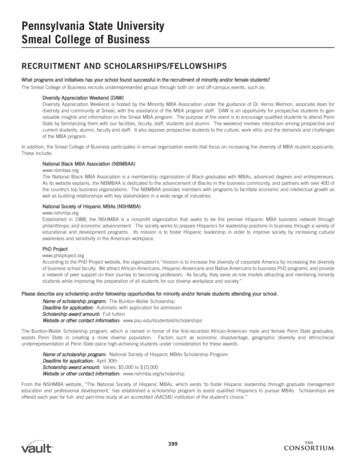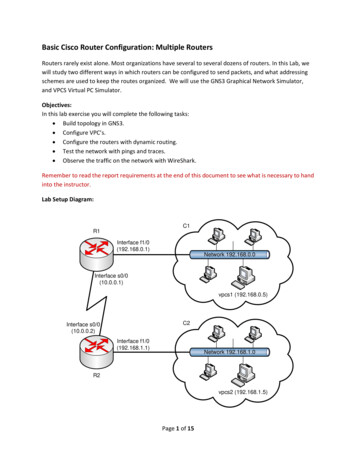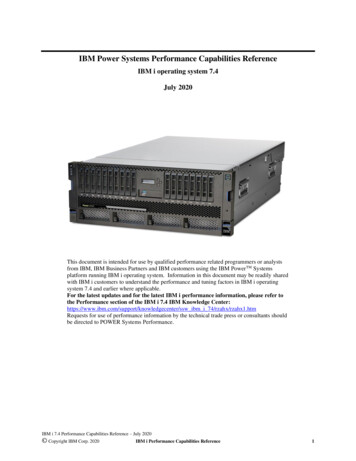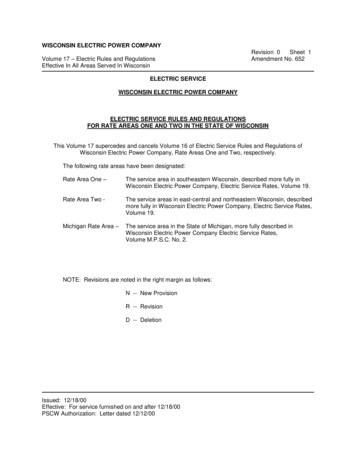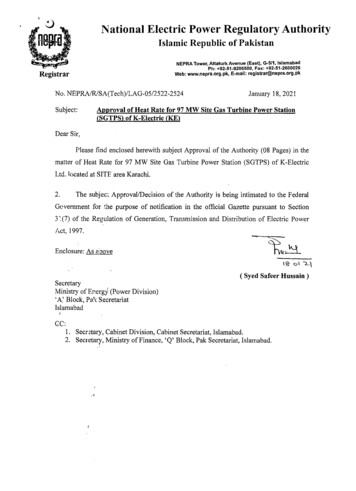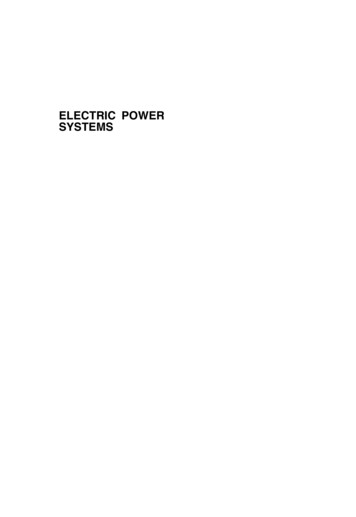
Transcription
ELECTRIC POWERSYSTEMS
ELECTRIC POWERSYSTEMSA CONCEPTUAL INTRODUCTIONAlexandra von MeierA JOHN WILEY & SONS, INC., PUBLICATION
Copyright # 2006 by John Wiley & Sons, Inc. All rights reservedPublished by John Wiley & Sons, Inc., Hoboken, New JerseyPublished simultaneously in CanadaNo part of this publication may be reproduced, stored in a retrieval system, or transmitted in any formor by any means, electronic, mechanical, photocopying, recording, scanning, or otherwise, except aspermitted under Section 107 or 108 of the 1976 United States Copyright Act, without either the priorwritten permission of the Publisher, or authorization through payment of the appropriate per-copy feeto the Copyright Clearance Center, Inc., 222 Rosewood Drive, Danvers, MA 01923, (978) 750-8400,fax (978) 750-4470, or on the Web at www.copyright.com. Requests to the Publisher for permissionshould be addressed to the Permissions Department, John Wiley & Sons, Inc., 111 River Street, Hoboken,NJ 07030, (201) 748-6011, fax (201) 748-6008, or online at http://www.wiley.com/go/permission.Limit of Liability/Disclaimer of Warranty: While the publisher and author have used their best effortsin preparing this book, they make no representations or warranties with respect to the accuracy or completeness of the contents of this book and specifically disclaim any implied warranties of merchantabilityor fitness for a particular purpose. No warranty may be created or extended by sales representatives orwritten sales materials. The advice and strategies contained herein may not be suitable for your situation.You should consult with a professional where appropriate. Neither the publisher nor author shall be liablefor any loss of profit or any other commercial damages, including but not limited to special, incidental,consequential, or other damages.For general information on our other products and services or for technical support, please contact ourCustomer Care Department within the United States at (800) 762-2974, outside the United States at(317) 572-3993 or fax (317) 572-4002.Wiley also publishes its books in a variety of electronic formats. Some content that appears in print maynot be available in electronic formats. For more information about Wiley products, visit our Web site atwww.wiley.com.Library of Congress Cataloging-in-Publication Data:Meier, Alexandra von.Electric power systems: a conceptual introduction/by Alexandra von Meier.p. cm.“A Wiley-Interscience publication.”Includes bibliographical references and index.ISBN-13: 978-0-471-17859-0ISBN-10: 0-471-17859-41. Electric power systems. I. TitleTK1005.M37 2006621.31–dc222005056773Printed in the United States of America10 9 8 7 65 4 32 1
To my late grandfatherKarl Wilhelm Claubergwho introduced me toThe Joy of Explaining Things
&CONTENTSPrefacexiii1. The Physics of Electricity1.11.21.31.41.5Basic roductionChargePotential or VoltageGroundConductivityCurrentOhm’s law81.2.1 Resistance1.2.2 Conductance1.2.3 Insulation91011Circuit Fundamentals111.3.11.3.21.3.31.3.411121313Static ChargeElectric CircuitsVoltage DropElectric ShockResistive Heating141.4.1 Calculating Resistive Heating1.4.2 Transmission Voltage and Resistive Losses1517Electric and Magnetic The Field as a ConceptElectric FieldsMagnetic FieldsElectromagnetic InductionElectromagnetic Fields and Health EffectsElectromagnetic Radiation2. Basic Circuit Analysis2.11Modeling Circuits3030vii
viii2.22.32.4CONTENTSSeries and Parallel Circuits312.2.12.2.22.2.32.2.432333536Resistance in SeriesResistance in ParallelNetwork ReductionPractical AspectsKirchhoff’s Laws372.3.12.3.22.3.32.3.438394041Kirchhoff’s Voltage LawKirchhoff’s Current LawApplication to Simple CircuitsThe Superposition PrincipleMagnetic Circuits3. AC Power3.13.23.33.44449Alternating Current and Voltage493.1.1 Historical Notes3.1.2 Mathematical Description3.1.3 The rms .1 Definition of Electric Power3.3.2 Complex Power3.3.3 The Significance of Reactive Power666873Phasor Notation753.4.1 Phasors as Graphics3.4.2 Phasors as Exponentials3.4.3 Operations with Phasors7578804. Generators854.1The Simple Generator864.2The Synchronous Generator924.2.1 Basic Components and Functioning4.2.2 Other Design Aspects92974.3Operational Control of Synchronous e Generator: Real PowerSingle Generator: Reactive PowerMultiple Generators: Real PowerMultiple Generators: Reactive Power
CONTENTSix4.4Operating Limits1154.5The Induction Generator1184.5.1 General Characteristics4.5.2 Electromagnetic Characteristics118120Inverters1234.65. Loads1275.15.25.3Resistive LoadsMotorsElectronic Devices1281311345.4Load from the System Perspective1365.4.1 Coincident and Noncoincident Demand5.4.2 Load Profiles and Load Duration Curve137138Single- and Multiphase Connections1405.56. Transmission and Distribution6.16.26.36.46.5144System 147149150153156158Historical NotesStructural FeaturesSample DiagramTopologyLoop FlowStations and SubstationsReconfiguring the SystemThree-Phase 3164166166167Rationale for Three PhasesBalancing LoadsDelta and Wye ConnectionsPer-Phase AnalysisThree-Phase PowerD.C. TransmissionTransformers1686.3.1 General Properties6.3.2 Transformer Heating6.3.3 Delta and Wye Transformers168170172Characteristics of Power Lines1756.4.1 Conductors6.4.2 Towers, Insulators, and Other Components175179Loading1826.5.1 Thermal Limits6.5.2 Stability Limit182183
xCONTENTS6.66.7Voltage ControlProtection6.7.1 Basics of Protection and Protective Devices6.7.2 Protection Coordination7. Power Flow Analysis7.17.27.37.47.58.28.38.4195IntroductionThe Power Flow Problem7.2.1 Network Representation7.2.2 Choice of Variables7.2.3 Types of Buses7.2.4 Variables for Balancing Real Power7.2.5 Variables for Balancing Reactive Power7.2.6 The Slack Bus7.2.7 Summary of Variables195197197198201201202204205Example with Interpretation of Results2067.3.1 Six-Bus Example7.3.2 Tweaking the Case7.3.3 Conceptualizing Power Flow206210211Power Flow Equations and Solution Methods2147.4.1 Derivation of Power Flow Equations7.4.2 Solution Methods7.4.3 Decoupled Power Flow214217224Applications and Optimal Power Flow2268. System Performance8.1184188188192229Reliability2298.1.1 Measures of Reliability8.1.2 Valuation of 8.3.38.3.4234236240249The Concept of StabilitySteady-State StabilityDynamic StabilityVoltage StabilityPower Quality2508.4.1 Voltage8.4.2 Frequency8.4.3 Waveform251253255
CONTENTS9. System Operation, Management, and New Technology9.19.29.39.4xi259Operation and Control on Different Time TheScale of a CycleScale of Real-Time OperationScale of SchedulingPlanning ScaleNew geDistributed GenerationAutomationFACTSHuman s and EngineersCognitive Representations of Power SystemsOperational CriteriaImplications for Technological InnovationImplications for Restructuring292Appendix: Symbols, Units, Abbreviations, and Acronyms298Index302
&PREFACEThis book is intended to bridge the gap between formal engineering texts and morepopularly accessible descriptions of electric power technology. I discovered thisgap as a graduate student struggling to understand power systems—especially transmission and distribution systems—which had always fascinated me but which nowinvited serious study in the context of research on implementing solar energy.Although I had studied physics as an undergraduate, I found the subject of powersystems difficult and intimidating.The available literature seemed to fall into two categories: easy-to-read, qualitative descriptions of the electric grid for the layperson, on the one hand, and highlytechnical books and papers, on the other hand, written for professionals andelectrical engineering majors. The second category had the information I needed,but was guarded by a layer of impenetrable phasor diagrams and other symbolismthat obviously required a special sort of initiation.I was extremely fortunate to have access to some of the most highly respectedscholars in the field at the University of California, Berkeley, who were also generous, patient, and gifted teachers. Thus I survived Leon Chua’s formidable course oncircuit analysis, followed by two semesters of power engineering with Felix Wu.This curriculum hardly made me an expert, but it did enable me to decipher thelanguage of the academic and professional literature and identify the issues relevantto my work.I enjoyed another marvelous learning opportunity through a research projectbeginning in 1989 at several large nuclear and fossil-fueled steam generationplants, where our team interviewed the staff as part of a study of “High-ReliabilityOrganizations.” My own subsequent research on power distribution took me into thefield with five U.S. utilities and one in Germany. Aside from the many intriguingthings we learned about the operating culture in these settings, I discovered howclearly the power plant staff could often explain technical concepts about theirworking systems. Their language was characteristically plain and direct, and wasalways guided by practical considerations, such as what this dial tells you, orwhat happens when you push that button.In hindsight, the defining moment for inspiring this book occurred in the Pittsburgcontrol room when I revealed my ignorance about reactive power (just after havingboasted about my physics degree, to the operators’ benign amusement). They generously supplied me with a copy of the plant operating manual, which turned out tocontain the single most lucid and comprehensible explanation of electric generators,xiii
xivPREFACEincluding reactive power, I had seen. That manual proved to me that it is possible towrite about electric power systems in a way that is accessible to audiences who havenot undergone the initiation rites of electrical engineering, but who neverthelesswant to get the real story. This experience suggested there might be other peoplemuch like myself—outside the power industry, but vitally concerned with it—who could benefit from such a practical approach.After finishing my dissertation in 1995, I decided to give it a try: My goal was towrite the book that I would have liked to read as a student six or seven years earlier.Considering that it has taken almost a decade to achieve, this turned out to be a muchmore ambitious undertaking than I imagined at the outset. A guiding principlethroughout my writing process was to assume a minimum of prior knowledgeon the part of the readers while trying to relate as much as possible to their directexperience, thus building a conceptual and intuitive understanding from theground up. I hope the book will serve as a useful reference, and perhaps even as asource of further inspiration for others to study the rich and complex subject ofelectric power.I envision two main audiences for this book. The first consists of students andresearchers who are learning about electric circuits and power system engineeringin an academic setting, and who feel that their understanding would be enhancedby a qualitative, conceptual emphasis to complement the quantitative methodsstressed in technical courses. This audience might include students of diverse backgrounds or differing levels of preparation, perhaps transferring into an engineeringprogram from other disciplines. Such students often need to solidify theirunderstanding of basic information presumed to be second nature for advancedundergraduates in technical fields. As a supplement to standard engineering texts,this volume aims to provide a clear and accessible review of units, definitions,and fundamental physical principles; to explain in words some of the ideas conventionally shown by equations; to contextualize information, showing connectionsamong different topics and pointing out their relevance; and to offer a glimpseinto the practical world of the electric power industry.The second major audience consists of professionals working in and around thepower industry whose educational background may not be in electrical engineering,but who wish to become more familiar with the technical details and the theoreticalunderpinnings of the system they deal with. This group might include analystsand administrators and managers coming from the fields of business, economics,law, or public policy, as well as individuals with technical or multidisciplinarytraining in areas other than power engineering. In view of the scope and importanceof contemporary policy decisions about electricity supply and delivery, both in theUnited States and abroad—from the siting of power generation and transmissionfacilities to market regulation and restructuring—a real need appears for a coherent,general education on the subject of power systems. My hope is that this volume canmake a meaningful contribution.
&ACKNOWLEDGMENTSMany individuals and organizations have made the writing of this text possible. I amdeeply grateful to my teachers for their mentorship, inspiration, and clarity, mostespecially Gene Rochlin, Felix Wu, and Oscar Ichazo. I am also indebted to themany professionals who took the time to show me around power systems inthe field and teach me about their work. The project was supported directly andindirectly by a University of California President’s Postdoctoral Fellowship,the University of California Energy Institute (UCEI), the California EnergyCommission’s Public Interest Energy Research (PIER) program, and the CaliforniaInstitute for Energy Efficiency (CIEE). I especially thank Carl Blumstein, SeverinB
ously supplied me with a copy of the plant operating manual, which turned out to contain the single most lucid and comprehensible explanation of electric generators, xiii. including reactive power, I had seen. That manual proved to me that it is possible to write about electric power systems in a way that is accessible to audiences who have not undergone the initiation rites of electrical engi
